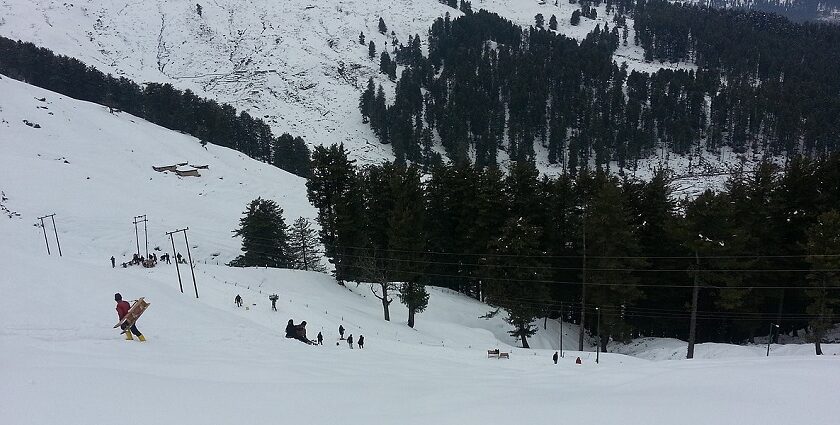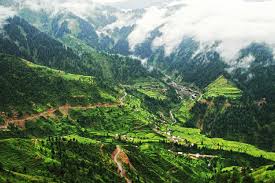When most travelers plan a trip to Jammu & Kashmir, their eyes usually light up at the thought of Kashmir, the snow, the valleys, the shikaras on Dal Lake. But let me pause you right here: Jammu is not just a transit point to Kashmir, it’s a treasure trove in itself.
Think of Jammu as the soulful, spiritual, and cultural heartland of the region. While Kashmir is about natural grandeur, Jammu is where faith, heritage, and serene landscapes converge. Whether you are a pilgrim heading to Vaishno Devi, a history buff curious about forts and palaces, or a nature enthusiast who loves lakes and hills, the places to visit in Jammu will surprise you with their variety and charm.
In this blog, let’s explore the 10 best places to visit in Jammu, with insider tips, tricks, and practical notes to make your travel effortless and enjoyable.
The top 10 Places to Visit in Jammu
1. Vaishno Devi Temple, Katra – The Spiritual Crown of Jammu
No list of places to visit in Jammu can ever start without mentioning the world-famous Vaishno Devi Temple. Located about 50 km from Jammu city in the town of Katra, this shrine is one of the most visited religious destinations in India. Dedicated to Goddess Vaishno Devi, the temple is nestled in the Trikuta Hills, nearly 5,200 feet above sea level.
You know that the town of Katra is purely vegetarian, which means you will not find even eggs being sold in any eatery or shop. But the town is known for its piping hot gulab jamuns and stuffed parathas.

Why Visit?
- The 13 km trek from Katra to the shrine is more than just a walk, it’s a spiritual experience where chants of “Jai Mata Di” echo all around.
- Facilities like battery cars, ponies, palkis, and even helicopter services are available for those who cannot trek the entire stretch. If you want to book a service in advance or want to know more about the services available checkout their official website here.
- The temple is open all year round, making it accessible regardless of when you travel.
Tips for Travelers:
- Register online before starting the trek; it’s free but mandatory.
- Even in summer, carry a light jacket since nights at the top are cool.
- If you want fewer crowds, avoid Navratri and New Year holidays.
2. Raghunath Temple, Jammu City – The Architectural Gem
Located in the heart of Jammu city, Raghunath Temple is another iconic site you must include in your itinerary. Built in 1857 by Maharaja Gulab Singh and completed by his son Maharaja Ranbir Singh, this temple is dedicated to Lord Rama but also houses shrines of other deities. This is easily one of the best temples on the list of best places to visit in Jammu.
Why Visit?
- The temple complex consists of seven shrines, each designed with exquisite architecture.
- Inside, you’ll see wall paintings illustrating scenes from the Ramayana, Mahabharata, and Bhagavad Gita.
- Its location in the vibrant Raghunath Bazaar makes it the perfect combination of spirituality and shopping.
Tips for Travelers:
- Visit early morning to avoid the heavy footfall.
- Explore Raghunath Bazaar for souvenirs, saffron, dry fruits, and traditional Dogra jewelry.
- Cameras and phones are not allowed inside the temple, so please respect the rules.

3. Mansar Lake – Nature and Mythology Together
Among the most peaceful places to visit in Jammu, Mansar Lake is around 62 km from Jammu city. The lake, bordered by lush forests and hills, is a beautiful picnic and boating spot.
Why Visit?
- Mythologically, it is linked to Sheshnag, the serpent god. Rituals and religious ceremonies are often performed here.
- Apart from its religious significance, the lake is popular for boating, bird-watching, and photography.
- A landscaped promenade surrounds the lake, making it easy for long walks.
Tips for Travelers:
- Carry light snacks and water as food options are limited.
- The best time to visit is between October and April, when the weather is comfortable.
- If time permits, pair it with a visit to Surinsar Lake, located nearby.
4. Akhnoor Fort & Jia Pota Ghat – The Historic Charms
For history lovers, Akhnoor Fort along the banks of the Chenab River is a fascinating spot. Built in the 17th century by Raja Alam Singh, the fort is steeped in stories of Dogra rulers and invasions. he site is not just about the fort, Akhnoor is considered historically important because excavations here have revealed remnants of the Harappan Civilization (Indus Valley sites)
Why Visit?
- The fort offers panoramic views of the Chenab River, making it a photographer’s delight.
- Nearby Jia Pota Ghat is historically important—it’s where Maharaja Ranjit Singh was crowned in 1808.
- The location makes for a peaceful outing away from city bustle.
Tips for Travelers:
- Wear comfortable shoes as the steps are uneven.
- Plan your visit around sunset for the best views.
- Carry drinking water; facilities are limited in the area.
5. Shivkhori Cave Temple – Mystical Spirituality
Another must-visit pilgrimage spot in Jammu is the Shivkhori Cave Temple, located about 70 km from Katra. Dedicated to Lord Shiva, this natural cave stretches 150 meters deep. If you love mystery and spirituality, this temple will be one of the best places to visit in Jammu for you.
Why Visit?
- The cave houses a naturally formed Shivling, believed to be self-manifested and eternal.
- Inside, fascinating stalagmite formations resemble divine figures, adding to its mystical aura.
- The approach to Shivkhori passes through scenic hills and villages, making the journey beautiful.
Tips for Travelers:
- Wear shoes with a strong grip—the cave floor can be slippery.
- Carry a flashlight even though the cave has dim lighting.
- Mahashivratri is the best time for a cultural experience, though it gets crowded.
6. Mubarak Mandi Palace – Royal Grandeur of Jammu
No exploration of places to visit in Jammu is complete without stepping into its royal past. The Mubarak Mandi Palace was once the residence of Dogra rulers and is now a heritage site.
Why Visit?
- The palace complex showcases a mix of Rajasthani, Mughal, and European architecture.
- The highlight is the Sheesh Mahal, adorned with stunning mirror work.
- The Dogra Art Museum inside exhibits rare manuscripts, Pahari miniature paintings, and artifacts.
Tips for Travelers:
- Opt for a guided tour to fully appreciate the history.
- Visit during the day when the museum is open.
- Wear a hat or carry water—summers in Jammu can be hot.
7. Patnitop – Jammu’s Hill Paradise
When you need a break from the heat of the plains, Patnitop comes to the rescue. Situated about 112 km from Jammu, this hill station is perched on a plateau in the Shivalik Range. This is easily one of the best places to visit in Jammu.

Why Visit?
- Patnitop is famous for its pine forests, meadows, and panoramic mountain views.
- Adventure lovers can indulge in paragliding, skiing (winter), zorbing, and trekking.
- Trekking trails to Nathatop and Sanasar Lake start from here.
Tips for Travelers:
- Pack warm clothes, irrespective of the season, as it gets cold in the evenings, even in summer.
- Winter (Dec–Feb) is perfect if you want to experience snow.
- Book accommodations in advance during peak tourist seasons.
8. Sanasar Lake – Mini Gulmarg of Jammu
If Patnitop whets your appetite for mountain landscapes, go a little further to discover Sanasar Lake. Surrounded by coniferous forests, this hidden gem among the best places to visit in Jammu is just 20 km from Patnitop.
Why Visit?
- Known as the “Mini Gulmarg of Jammu”, it offers a blend of serenity and adventure.
- Activities include camping, paragliding, horse riding, and rock climbing.
- At night, Sanasar is ideal for stargazing under clear skies.
Tips for Travelers:
- Stay overnight in camps to soak in the experience.
- Carry warm clothing—it gets chilly after dark.
- Expect poor mobile network, which is a blessing if you want a digital detox.
9. Peer Kho Cave Temple – Ancient Spiritual Spot
Another gem in the list of places to visit in Jammu is the Peer Kho Temple, located near the banks of the Tawi River.
Why Visit?
- Also known as Jamvant Cave Temple, it is associated with Jamvant from the Ramayana.
- The temple is built inside a natural cave, giving it a mystical vibe.
- During Shivratri, the temple becomes a vibrant center of festivities.
Tips for Travelers:
- Visit during early morning or evening aarti for a spiritual experience.
- Be careful while climbing the steep steps leading down.
- After your visit, enjoy a peaceful riverside walk along the Tawi.
10. Bahu Fort & Bagh-e-Bahu Garden – History Meets Serenity
Perched on the banks of the Tawi River, Bahu Fort is one of the oldest structures in Jammu, believed to be over 3,000 years old.
Why Visit?
- The fort houses the temple of Bawe Wali Mata (Goddess Kali), highly revered by locals.
- The adjoining Bagh-e-Bahu Garden is beautifully landscaped with fountains and colorful flower beds.
- In the evening, the musical fountain show is a delight, especially for families.
Tips for Travelers:
- Wear comfortable shoes; the fort involves a steep climb.
- Sunset from the fort gives a breathtaking view of Jammu city.
- Don’t miss the musical fountain show in the gardens.
Practical Travel Guide to Places to Visit in Jammu
Now that we’ve covered the best places to visit in Jammu, here are some handy details to make your trip smooth:
Best Time to Visit Jammu
- October to March: Pleasant weather, ideal for sightseeing.
- April to June: Hot in plains but good for visiting Patnitop and Sanasar.
- July to September: Monsoon season; expect heavy rains with occasional flash floods and risks of landslides.
How to Get Around
- Within Jammu city: Autos and taxis are easily available.
- For day trips: Hire private cabs or join group tours.
Must-Try Food in Jammu
- Rajma-Chawal (Jammu style)
- Kaladi Kulcha – a cheesy delight unique to the region
- Patisa – a flaky sweet often taken home as a souvenir
Shopping in Jammu
- Dry fruits, basmati rice, saffron, Dogra jewelry, and Pashmina shawls.
Safety & Etiquette
- Jammu is generally safe, but practice basic travel safety.
- Respect temple customs, remove shoes, dress modestly.
Final Thoughts
Jammu is often overshadowed by its glamorous sibling, Kashmir, but if you take time to explore, you’ll discover that Jammu has its own rhythm, soul, and magic.
From the spiritual aura of Vaishno Devi to the tranquil lakes of Mansar and Sanasar, from the royal grandeur of Mubarak Mandi Palace to the cool meadows of Patnitop the places to visit in Jammu offer a complete travel experience.
So, the next time you plan your trip north, don’t just rush through Jammu. Stay a while, explore, and let this underrated gem surprise you.
This is your ultimate guide to discovering the heart and soul of Jammu, beyond the usual travel narratives. We’ll delve into the must-see sites, uncover hidden gems, and give you a sense of what makes this city so special. So, pack your bags and get ready for a journey that promises to be both spiritually enriching and visually stunning.
❓ Frequently Asked Questions About Places to Visit in Jammu
1. What is Jammu famous for?
Jammu is famously known as the “City of Temples.” It’s the starting point for the Vaishno Devi pilgrimage in Katra, but beyond that, Jammu is rich in heritage forts, royal palaces, serene lakes like Mansar and Sanasar, and hill stations such as Patnitop. The blend of spirituality, history, and nature makes Jammu a complete travel destination.
2. How many days are enough to explore Jammu?
If you only want to visit Vaishno Devi, 2–3 days are sufficient. But to truly explore the top places to visit in Jammu—including Patnitop, Sanasar, Mubarak Mandi Palace, Bahu Fort, and lakes like Mansar—you’ll need at least 5–6 days.
3. Which is the best time to visit Jammu?
- October to March: Best for sightseeing and temple visits.
- April to June: Ideal for hill stations like Patnitop and Sanasar.
- Monsoon (July–September): Brings lush greenery but also occasional landslides, so travel carefully.
4. Is Jammu safe for tourists?
Yes, Jammu is considered safe for tourists. It is well connected by road, rail, and air, and the main tourist destinations are frequently visited by pilgrims and travelers. However, like any trip, follow basic safety tips—avoid isolated areas at night, keep emergency contacts handy, and stay updated on local weather.
5. What food is Jammu famous for?
Some must-try dishes in Jammu include:
- Rajma-Chawal (Jammu style) – a staple comfort food.
- Kaladi Kulcha – local cheese served with kulcha bread.
- Patisa – a sweet delicacy, perfect as a takeaway.
- Dogri cuisine specialties like ambal (sour pumpkin curry) and dal patt.
6. What are the most popular temples in Jammu?
The most visited temples in Jammu include:
- Vaishno Devi Temple (Katra)
- Raghunath Temple (Jammu city)
- Peer Kho Cave Temple
- Bahu Fort Temple (Bawe Wali Mata)
- Shivkhori Cave Temple
These make Jammu a truly spiritual destination.
7. Can I combine a Jammu trip with Kashmir?
Yes, absolutely. Jammu is the gateway to Kashmir. Most travelers spend a few days in Jammu before heading to Srinagar or Gulmarg. However, Jammu itself has enough attractions to warrant a stand-alone trip, especially if you’re interested in temples, heritage, and hill stations.
8. What are some offbeat places to visit in Jammu?
If you want to go beyond the popular spots, check out:
- Sanasar Lake – a hidden gem for camping and stargazing.
- Akhnoor Fort & Jia Pota Ghat – historic sites along the Chenab.
- Surinsar Lake – peaceful and less crowded than Mansar Lake.
- Dogra Art Museum inside Mubarak Mandi Palace – perfect for culture enthusiasts.
A City of Divine Blessings
Jammu is famously known as the “City of Temples,” and for good reason. The city is dotted with sacred shrines, each with its own story and architectural marvel. Visiting these places isn’t just a religious experience; it’s a deep dive into the region’s history and spiritual traditions.
1. Raghunath Temple: This is arguably the most famous temple complex in Jammu. Built in the 19th century by Maharaja Gulab Singh, and later completed by his son, Maharaja Ranbir Singh, the temple is a beautiful testament to the Dogra rulers’ devotion to Lord Rama. The complex is a series of seven shrines, each with its own spire. What truly sets it apart is the massive collection of shaligrams (fossilized ammonites representing Lord Vishnu) and lingams (representations of Lord Shiva) that fill the temple. The intricate carvings and the golden facade of the main temple make it a sight to behold, a place where you can feel the centuries of faith radiating from every stone.
2. Peer Kho Cave Temple: Nestled on the banks of the Tawi River, the Peer Kho Cave is one of the city’s oldest shrines. Legend has it that the cave is a natural formation and has been a place of worship since ancient times. The temple is dedicated to Lord Shiva and is a sanctuary of peace, offering a calm respite from the city’s noise. The cool, quiet atmosphere of the cave, with the constant trickle of water, creates an incredibly meditative environment. It’s a perfect spot for those seeking a moment of solitude and reflection.
3. Ranbireshwar Temple: Dedicated to Lord Shiva, this temple is a striking example of Dogra architecture. It was built by Maharaja Ranbir Singh in 1883 and is renowned for its massive, 8-foot-tall Shiva Lingam, carved from a single black stone. The temple also houses a collection of smaller crystal lingams, which are said to be rare and highly sacred. The grandeur of the main deity and the serene atmosphere make it a significant pilgrimage site, especially during the festival of Mahashivaratri when it comes alive with devotees.
A Walk Through Royal History and Grandeur
Beyond its temples, Jammu’s history is best told through its palaces and forts. These magnificent structures offer a glimpse into the lives of the Dogra kings and the rich cultural heritage they left behind.
4. Bahu Fort: Standing majestically on a hill overlooking the Tawi River, Bahu Fort is an enduring symbol of Jammu’s ancient history. The fort, believed to have been built by Raja Bahulochan more than 3,000 years ago and later renovated by the Dogra rulers, is a formidable structure with thick walls and a commanding presence. Inside the fort is the Bahu Temple, dedicated to Goddess Kali, a highly revered shrine that attracts a large number of devotees. The fort complex also houses a stunning terraced garden, Bagh-e-Bahu, with its beautiful fountains and manicured lawns, offering panoramic views of the city. It’s a great place to spend an afternoon, exploring the fort’s history and enjoying the serene beauty of the gardens.
5. Mubarak Mandi Palace: Once the royal residence of the Dogra dynasty, the Mubarak Mandi Palace is a sprawling complex that showcases a unique blend of Rajasthani, Mughal, and European architectural styles. While parts of the palace are in a state of disrepair, its grandeur is still evident. The complex is a fascinating journey through time, with various buildings like the Pink Palace, the Gol Ghar Complex, and the Dogra Art Museum. The museum, housed within the palace, is a treasure trove of art and artifacts from the Dogra period, including miniature paintings and royal memorabilia. A walk through the palace is like stepping back into an era of opulence and intricate craftsmanship.
6. Amar Mahal Palace Museum: This red-sandstone palace, designed in the style of a French chateau, was the last residence of the Dogra kings. Today, it has been converted into a museum that narrates the story of the dynasty through its impressive collection of artifacts, paintings, and a stunning golden throne. The architecture is a beautiful fusion of European and Indian styles, and the location on a hill overlooking the Tawi River adds to its charm. The museum offers a comprehensive look at the history and lifestyle of the Dogra rulers and is a must-visit for any history enthusiast.
Nature’s Abode: Lakes and Hill Stations
Jammu is not just about historical and religious sites; it’s also a place of breathtaking natural beauty. The region is home to serene lakes and charming hill stations that offer a perfect escape into the lap of nature.
7. Mansar and Surinsar Lakes: Known as the “twin lakes,” Mansar and Surinsar are both beautiful and hold mythological significance. Mansar Lake, surrounded by lush green hills, is a popular picnic spot and a place of religious importance. It is believed that a dip in its sacred waters can wash away sins. On its banks is a shrine dedicated to Sheshnag, the serpent god, and many newlyweds perform a ritual walk around the lake to seek his blessings. Surinsar Lake, a smaller but equally enchanting lake, is also a part of a wildlife sanctuary, making it a haven for bird watchers and nature lovers. These lakes offer a peaceful retreat, perfect for boating, nature walks, and simply soaking in the tranquility.
8. Patnitop: Located about 112 kilometers from Jammu city, Patnitop is a popular hill station known for its stunning natural beauty and adventure activities. The drive itself is a scenic journey through winding roads and pine forests. Patnitop offers breathtaking views of the Himalayas and is a paradise for photographers and nature enthusiasts. In the winter, it transforms into a winter wonderland, offering opportunities for skiing and other snow sports. Throughout the year, you can enjoy activities like trekking, paragliding, and simply picnicking in the widespread meadows.
Beyond the Usual: Exploring the Outskirts
For the adventurous traveler, there are a few more places just a little further out that are well worth the trip.
9. Shiv Khori: Located in the Reasi district, Shiv Khori is a famous cave shrine dedicated to Lord Shiva. The cave is a natural formation and is believed to have a mystical, sacred power. The trek to the cave itself is a beautiful experience, winding through picturesque landscapes. Inside, the cave holds a self-manifested Shiva Lingam, which is the main deity of worship. The spiritual energy and the natural wonder of the cave make it a truly unique and memorable experience.
10. Akhnoor Fort: Situated on the banks of the Chenab River, Akhnoor Fort is an ancient site that holds a special place in the history of the region. The fort is believed to be linked to the Harappan civilization and offers a glimpse into the ancient past. The massive defensive walls and the serene riverfront make it a peaceful and historically significant place to visit. The views of the river from the fort are particularly stunning, especially at sunset.
A Few Pro Tips for Your Jammu Trip
- Best Time to Visit: The best time to visit Jammu is during the autumn and winter months, from October to March. The weather is pleasant and ideal for sightseeing. The summer months (April to June) can be very hot, so if you’re traveling during this time, be prepared for high temperatures. The monsoon season (July to September) can bring heavy rainfall, which might disrupt your plans.
- Local Cuisine: A trip to Jammu is incomplete without trying its delectable local cuisine. Be sure to try Rajma Chawal, a staple of the region, and Kaladi Kulcha, a unique cheese-filled bread. The Ambal, a tangy pumpkin dish, and the local sweets like Patisa and Kheer are also must-try items.
- Getting Around: Within the city, you can use local autos and taxis. For trips to places like Patnitop or Shiv Khori, it’s best to hire a private car or a taxi for a comfortable journey.
Jammu is more than just a transit point; it’s a destination that will captivate your heart and soul. With its deep-rooted spirituality, magnificent historical sites, and tranquil natural landscapes, it offers a travel experience that is both fulfilling and unforgettable. So, go ahead, plan your trip, and discover the hidden wonders of this incredible city.
My Other Posts
If you are looking for options in Kashmir, check out my posts on Pahalgam, Gulmarg, Snowfall in Kashmir, and Best Time to Visit Kashmir. If you are looking for options in Ladakh, check out Ladakh Weather, Nubra Valley, 5 Days Kashmir Itinerary, Best Packing tips for Ladakh & best tourist places in Ladakh.
If you are looking for something in Sikkim, check Tsomgo Lake, Nathu La Pass, Baba Harbhajan Singh Mandir and Batasia Loop. If you are looking for some jungle safari read Gir Safari, or Bandipur Safari, feel blessed at Sri Venugopala Swamy Temple in Mysore.
If you are looking for places to visit in the Andaman Islands, please check my posts on Radhanagar Beach & Ross Island.
If you are looking for other options, check my posts on Murud Janjira, Kashid, Pirwadi Beach and Kihim Beach in Maharashtra or Malshej Ghat, Matheran Resorts, Kailash Temple Ellora, Vandri Lake, Kelwa Beach in Palghar & Mahabaleshwar.
Alternatively, if you are interested in some Religious tourism, please check my posts on Golden Temple, Kamakhya, Trimbakeshwar, Somnath Temple, Kalighat Temple, Dakshineswar Temple and Kashi Vishwanath. If you are looking for North East Adventure tours, check my posts on Shillong, Meghalaya, Dawki, Double Decker Living Root Trek, and 7-Day North East Itinerary

